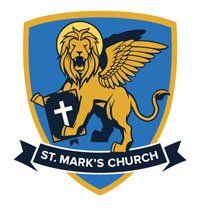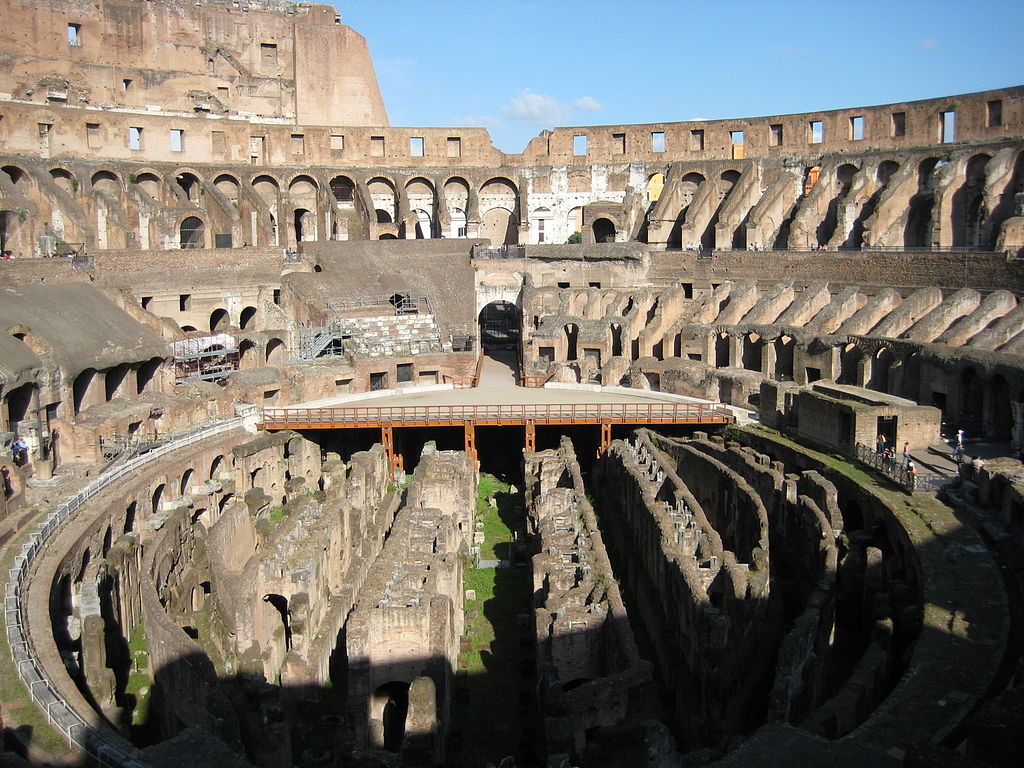The Winged Lion of St Mark
This carving is from the of portal of St. Trophime in Arles, France.
Christ is in the centre surrounded by symbols of the Four Evangelists:
- Matthew (human, upper left)
- Mark (lion, lower left)
- Luke (ox bull, lower right)
- John (eagle, upper right).
Below we see the row of the twelve Apostles.
Who was St Mark The Evangelist and why the Winged Lion?
Our church is named after Saint Mark, the writer of the Gospel. In the earliest Christian art the four Gospel writers were represented using the symbolism recorded in Revelation (4:7) of winged creatures. St Mark a lion, St Matthew a creature with a face like a human face, St Luke an ox, and St John a flying eagle. The lion symbolism also appears in a vision of the Prophet Ezekiel (1:10). The winged lion of St. Mark the Evangelist is used as the logo for our church. Mark begins his gospel with the mission of John the Baptist "crying out in the wilderness." His voice is said to have sounded like that of a roaring lion. St Mark the Evangelist is specially remembered in the church year on 25 April with this prayer:
Almighty God, who enlightened your holy Church through the inspired witness of your evangelist Saint Mark: grant that we, being firmly grounded in the truth of the gospel, may be faithful to its teaching both in word and deed; through Jesus Christ your Son our Lord, who is alive and reigns with you, in the unity of the Holy Spirit, one God, now and for ever. Amen
On the 25 April, the church celebrates St Mark the Evangelist, who wrote the first Gospel. He was not one of the 12 Apostles but he was a disciple of Jesus who was right at the heart of the events which surrounded the explosion of the Good News of Jesus and it was he who first put into writing the eye witness accounts of the life and times of Jesus. His writing about Jesus was so good that 90% of it is used by Matthew and over half by the Gospel of Luke. His writing has been dated soonest after the crucifixion and resurrection of Jesus, between AD60 and AD70AD.
From the Acts of the Apostles we learn that his Jewish name was John but they called him by his Latin name ‘Mark’. (Acts of the Apostles Acts 12:25, 13:5; 13, and 15:37). So we know that he was a Jewish Christian whose mother Mary owned a home in Jerusalem which was of sufficient size to use as a meeting place for the Apostles(Acts12:12). It is thought this might have been the ‘upper room’ where the Last Supper was held and where the disciples stayed after the ascension. From Acts we also learn that as well as being close to Peter, Mark was also the cousin of St Barnabas the apostle (Colossians 4:10). He accompanied Barnabas and Paul to Antioch (12:25) where he became their assistant on a mission journey (13:5). We don’t know why, but he fell out with Paul at Perga and left him and returned to Jerusalem (13:13). We do know that they later made up and Paul spoke of him affectionately as a ‘coworker for the Gospel (Col 4:10, 2 Tim 4:11, Philem 24). Whatever the earlier differences were, It was Mark that Paul wanted by his side at the end of his life.
From this biblical evidence we can see that Mark was right at the centre of the early Christian fellowship and Gospel events. Some have thought that Mark was speaking of himself when he wrote the description of Jesus' arrest in Gethsemane.
"Now a young man followed him wearing nothing but a linen cloth about his body. They seized him, but he left the cloth behind and ran off naked"
(Mark 14:51-52).
We cannot be sure of this but we do know that he was very close to the Apostle Peter who called him ‘my son Mark’ and he was with Peter in Rome (1 Peter 5:13). This is also confirmed by early church tradition dating back to the second century. Clement of Alexandria AD 150 -215), Irenaeus (AD115-202) and Papias (AD60-140) all speak of Mark as the “interpreter” or mouthpiece of the Apostle Peter, a disciple who accurately wrote down his memories. As we read through the Gospel there is much evidence of the eye witness detail which Peter has shared with Mark.
Church tradition tells us that after serving with Peter in Rome, Mark founded the church in Egypt and was made a bishop in Alexandria. He is believed to have died there a martyr, dragged through the street and his relics were eventually taken to Venice where they lie in the Basilica of St Mark. He is the patron saint of the city.
The Winged Lion
The Gospel of Mark concludes with the Lord's final greeting:
"Go into the whole world and proclaim the Gospel" (Mk 16:15).
Mark sees that Christian faith is something to be shared with others and never to be kept to ourselves.
As an evangelist, Mark wanted to spread the Good News and his Gospel has been seen to have a sense of urgency. One of the most used words in the Gospel is ‘immediately.’ Sometimes he addresses his readers directly. For example he wants those who read his Gospel to know that the power of Jesus to exercise the divine power of God to forgive is real. He says
‘That you may know that the Son of Man has authority to forgive sins on earth’ (2:10)
Mark knew that the followers of Jesus were being persecuted and so he doesn’t hide the sufferings of Jesus from his readers. He tells that even the family of Jesus thought that he had lost his mind (3:21). Jesus is a real person who trembles at his own approaching death (14:33) and who felt abandoned by God his Father (15:34).
When he was on his way to martyrdom in Rome Saint Ignatius (AD35-110) wrote
‘I flee to the Gospel as to the flesh of Christ’
He was saying that when he read the Gospel it wasn’t just a history of Jesus, these words supplied to him the very presence of Jesus. Christians believe that the Holy Spirit so inspires the words of the Gospel that through this writing that people are brought into a living experience of the presence of the risen Jesus. As we encounter Jesus through reading the words of Mark we encounter our Saviour Jesus Christ, Good News to be shared with all .
The Persecution of Christians when the Gospel of Mark was written
Mark wrote his Gospel in Rome around AD65. He was writing to the first Christians who often sometimes ended up here in the Roman ampitheatre. The Emperor Nero (AD64-68) brutally treated Christians after blaming them for the fire which destroyed Rome. When Mark wrote about Jesus being in the desert with wild beasts 1:13 this would have special meaning to Roman Christians, some of whom would end up here in the Roman Colosseum in these tunnels waiting to be killed as entertainment.




